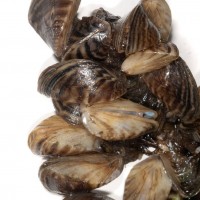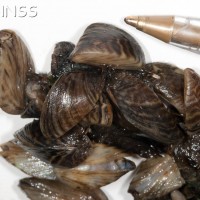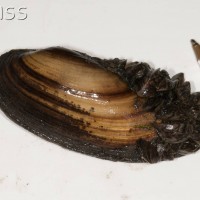
Zebra Mussel - Dreissena polymorpha
Expand and collapse the sections below by clicking on the title or + / - icons.
Short description of Dreissena polymorpha, Zebra Mussel
The Zebra mussel is a sessile bivalve mollusc of typically 20 mm (max. 40 mm) length and brownish-yellowish colour with a characteristic dark and light coloured (“zebra”) zigzag banding.
Impact summary: Dreissena polymorpha, Zebra Mussel
Due to its filtering capacity and ability to produce dense populations, it can significantly reduce native biodiversity, and alter whole freshwater ecosystems. It is also a nuisance and economic problem when growing in pipes of water treatment plants or commercial ships.
Habitat summary: Dreissena polymorpha, Zebra Mussel
It forms dense colonies attached to various hard substrates via byssal threads in both fresh and slightly brackish waters. Prefers moderately productive (mesotrophic) water bodies, and can be found in both flowing and standing water bodies.
Overview table
| Environment | Freshwater |
|---|---|
| Species status | Non-Native |
| Native range | Caucasus, Western Asia, Russia South, Krym, Ukraine |
| Functional type | Filter-feeder |
| Status in England | Non-Native |
| Status in Scotland | Non-Native |
| Status in Wales | |
| Location of first record | Wisbech (29) |
| Date of first record | 1825 |
Origin
Native to the drainage basins of the Black, Caspian and Aral Seas.
First Record
First recorded in GB in Wisbech in 1824 or 1825; probably independent introduction into Scotland (first recorded near Edinburgh in 1833 but with no evidence of establishment).
Pathway and Method
It is assumed to have been introduced into GB on timber imported on ships from the Baltic Sea.
Species Status
There are historic first records from Southeast England (early 1820s), the Glasgow and Edinburgh canal systems (early 1830s). Although the species failed to establish in Scotland, by the 1850s it had spread throughout the canal basin of England and Wales. In the 1920’s it appeared in Sweden, in the 1960’s it was found in lakes around the Alps and reached Italy in 1977, Ireland by 1994 and Spain by 2001. In 1988 it first appeared in Lake St. Clair (USA) and rapidly spread throughout the Great Lakes of North America. Further range expansions are expected in temperate latitudes of the Northern Hemisphere. British population numbers were seen to decline during the 1980s, but since 1999 there has been a dramatic increase in the abundance of this species throughout much of southern and eastern England, including the lower River Thames and the rivers of the Norfolk Broads.
Dispersal Mechanisms
Zebra mussel larvae are able to drift downstream for 3–4 weeks and up to 300 km before they attach and found new populations, but humans are responsible for most introductions of into new areas. Adults can attach to boats and are thus quickly transported to new sites. Larvae can be transported in fish and bait wells as well as in cooling ports of motors. The most likely introduction vector is shipping (e.g. in ballast water, on timber or river gravel).
Reproduction
It is a prolific breeder, with a fully mature mussel being capable of producing up to one million eggs per season, thus enabling a single mussel to establish a new population. Synchronised spawning occurs once >8 mm, begins at 12-15ºC and may take place over a period of 3-5 months.
Known Predators/Herbivores
These small molluscs are preyed upon by different fish species (e.g. roach, carp, and eel) and also diving ducks, crayfish and muskrats.
Resistant Stages
It is able to tolerate low oxygen content in water for several days and to survive out of water under cool damp conditions for up to three weeks.
Habitat Occupied in GB
Slow rivers, canals, docks, reservoirs, power station cooling systems, water treatment facilities, water pipelines. The mussel attaches to solid surfaces such as stones, native (unionid) mussels and canal walls using byssus threats. It can colonise soft sediments once dead zebra mussel shells have accumulated to create a suitable substrate.
Estbalished, common and widespread across England and Wales, and recorded (but not established) from some parts of Scotland. Also established in almost all central and western Europe, north-west Russia, and parts of North America.
Environmental Impact
Being an active filter feeder with each adult mussel of filtering one or more litres of water each day, large populations of zebra mussels threaten the survival of native faunas by reducing the available amount of nutrients and oxygen, and cause severe habitat alterations. The species’ high consumption of phytoplankton results in increased water clarity. It competes for space and food with native mussels and other filter-feeding organisms, and attachment on mussel shells can cause severe reductions and extirpation of native mussel populations.
Health and Social Impact
The sharp shells may cause injuries in recreational areas. It is also a nuisance when it grows on recreational boats.
Economic Impact
Zebra mussels can clog water pipes, filters and turbines, and have become a major pest in water treatment works and power station intakes. Further economic areas affected include fisheries (interference with fishing gear, alteration of fish communities), aquaculture (fouling of cages) and aquatic transport (fouling of ship hulls and navigational constructions). In North America, Zebra mussel invasions are causing annual multimillion losses to the economy.
Identification
Killeen, I., Aldridge, D.C. & Oliver, G. (2004) Freshwater Bivalves of Britain and Ireland. Field Studies Council.
Biology, ecology, spread, vectors
Aldridge, D.C., Elliott, P. & Moggridge, G.D. (2004) The recent and rapid spread of the zebra mussel (Dreissena polymorpha) in Great Britain. Biological Conservation, 119, 253-261.
Ricciardi, A., Serrouya, R. & Whoriskey, F.G. (1995) Aerial exposure tolerance of zebra and quagga mussels (Bivalvia: Dreissenidae): implications for overland dispersal. Canadian Journal of Fisheries and Aquatic Sciences, 52, 470-477.
Son, M. (2007) Native range of zebra mussel and quagga mussel and new data on their invasions within the pontocaspian region. Aquatic Invasions, 3.
Management and impact
Aldridge, D.C., Elliott, P. & Moggridge, G.D. (2006) Microencapsulated BioBullets for the Control of Biofouling Zebra Mussels. Environmental Science & Technology, 40, 975–979.
Claudi, R. & Mackie, G. (1994) Practical manual for zebra mussel monitoring and control. Lewis Publishers, Boca Raton, Florida.
Connelly, N., O’Neill, C., Knuth, B. & Brown, T. (2007) Economic impacts of zebra mussels on drinking water treatment and electric power generation facilities. Environmental Management, 40, 105–112.
Karatayev, A., Burlakova, L. & Padilla, D. (2002) Impacts of Zebra Mussels on Aquatic Communities and their Role as Ecosystem Engineers. Invasive aquatic species of Europe – distribution, impacts and management (eds E. Leppäkoski, S. Gollasch & O. S), pp. 433-446. Kluwer Academic, Dordrecht, Boston, London.
Ricciardi, A., Neves, R.J. & Rasmussen, J.B. (1998) Impending extinctions of North American freshwater mussels (Unionoida) following the zebra mussel (Dreissena polymorpha) invasion. Journal of Animal Ecology, 67, 613-619.
General
Nalepa, T.F. & Schloesser, D.W. (1993) Zebra Mussels: Biology, Impacts, and Control. Lewis Publishers, Boca Raton, Florida.
Neumann, D. & Jenner, H. (1992) The zebra mussel Dreissena polymorpha: ecology, biological monitoring and first applications in the water quality management. Gustav Fischer, Stuttgart.
Olenin, S., Orlova, M. & Minchin, D. (1999) Dreissena polymorpha (Pallas, 1771). Case histories on introduced species: their general biology, distribution, range expansion and impact (eds S. Gollasch, D. Minchin, H. Rosenthal & M. Voigt), pp. 37-42. Logos-Verlag, Berlin.
Spotted this species?
Distribution map
View the Distribution map for Zebra Mussel, Dreissena polymorpha from NBN Atlas
ID Sheet
ID Sheet for Dreissena polymorpha . See a full list of non-native species ID Sheets.
Risk assessment
Risk assessment for Dreissena polymorpha. See a full list of non-native species Risk assessments.
Watch a video about this species


















